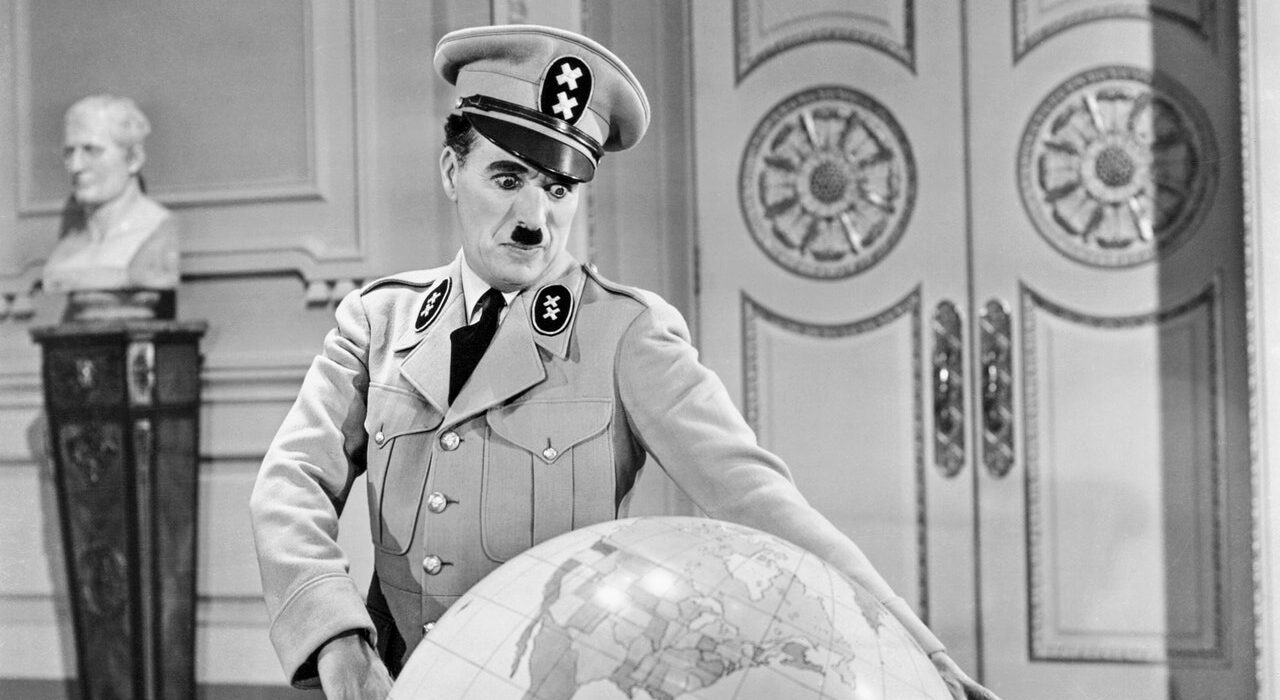The Tramp was born in the wardrobe department of Keystone Studios, in Los Angeles. The year was 1914, and Charlie Chaplin was a twenty-four-year-old contract player. Keystone was known for its slapstick comedies, and pantomime was more Chaplin’s comic genre. At first, nobody seemed sure what to do with him. Then one day the head of the studio, Mack Sennett, sensed that a scene they were shooting needed some funny business. Chaplin happened to be standing nearby. Sennett ordered him to put on comedy makeup—“anything will do.”
On his way to wardrobe, Chaplin decided that everything should be a contradiction: a coat and hat that were too small, pants and shoes that were too big. Since the character was not supposed to be young, he added the mustache—very small, so it wouldn’t hide his expression. He performed the scene; Sennett loved it; and the Tramp was launched on his brilliant career.
In the earliest Tramp movies, “Mabel’s Strange Predicament” (seventeen minutes long) and “Kid Auto Races at Venice” (about six minutes), the Tramp character is annoying and disruptive. He smokes and he drinks. (Chaplin had sometimes played a drunk on the vaudeville stage.) But the character was popular, and after Chaplin added the Pierrot element, the touch of poetry, the Tramp as we know him came into being.
“You know this fellow is many-sided,” as Chaplin explained the character to Sennett, “a tramp, a gentleman, a poet, a dreamer, a lonely fellow, always hopeful of romance and adventure. He would have you believe he is a scientist, a musician, a duke, a polo player.” In short, the Tramp was an Everyman, and his creator became, to his not completely happy surprise, an object of fan hysteria on a par with Rudolph Valentino.
Soon, Chaplin was writing and directing all his movies, as he would do for the rest of his career. He made dozens of pictures in the silent era. In 1919, he became a co-owner—with Douglas Fairbanks (a close friend), Mary Pickford, and D. W. Griffith—of a distribution company, United Artists. He built his own studio, in La Brea, where he controlled every aspect of production.
And he financed his movies with his own money, which meant that he could shoot at his own pace and pocket (minus a distribution fee to U.A.) all the profits. An émigré who had spent much of his childhood in poverty, including time in a London workhouse, and who had at best a fourth-grade education, Chaplin became, almost overnight, one of the most successful filmmakers in Hollywood. Since cinema was, from the start, an international art form, the Tramp also made Chaplin one of the most famous people in the world.
Chaplin’s run of silents continued into the talkie era. Two of the most iconic silent movies ever made, “City Lights” (1931) and “Modern Times” (1936), were made long after the shift to sound. Chaplin gambled that there was still an audience for silent movies. He also knew that once the Tramp spoke he would cease being an Everyman and become merely an Englishman.
Those films embodied, for many people, a distinctive attitude toward life in the twentieth century. City Lights became the name of the San Francisco publisher that put out Allen Ginsberg’s “Howl” (1956) and other dissident works; Les Temps Modernes was the name of the intellectual journal founded in Paris in 1945 by the existentialists Jean-Paul Sartre and Simone de Beauvoir. The Tramp was evoked during the Berkeley Free Speech Movement in the nineteen-sixties and the Solidarity movement in Poland in the nineteen-eighties. The Tramp stood for the Individual against the System.
In 1940, Chaplin made his first talkie, a satire of Hitler and Mussolini called “The Great Dictator.” It was a huge hit. And then the sky fell. The country, or a very noisy part of it, turned against him, and eventually, after a decade of critical and political abuse, Chaplin left the United States, cashed out his American assets, bought a house in Switzerland, and did not return for twenty years.
That was in 1972, when Chaplin was eighty-two and frail. He came back to accept an honorary Oscar, and was greeted with a twelve-minute ovation, said to be the longest in the history of the Academy Awards. By then, accusations that had once been damaging—of sexual libertinage and Communist sympathies—had lost most of their force.
Still, even for people who were not around when the reputational crash occurred, the shadow of the old charges lingered. The image of Chaplin the man had become virtually the inverse of the Tramp’s: oversexed, ungenerous, anti-American. Scott Eyman’s “Charlie Chaplin vs. America” (Simon & Schuster) is an attempt to explain what happened.
The story is not new. Sadly, it’s not old, either. As Eyman says, it “eerily foretells the homicidal cultural and political life of the twenty-first century.” Chaplin was set upon by the mid-century equivalent of social media—newspaper columnists—and was targeted by a “weaponized” government agency, the F.B.I.
Chaplin’s chief antagonists among the columnists—whose audiences, in the days before television, were considerably larger than the audiences today for Fox News and MSNBC—were gossip columnists like Hedda Hopper and Walter Winchell (who also had a weekly radio show heard by twenty million people) and anti-Communist flamethrowers like Westbrook Pegler and Ed Sullivan, a vigorous enemy of subversives before he became defanged by serving as the man who introduced the Beatles to America. The proximate cause of Chaplin’s exile was the cancellation of his reëntry permit by Harry Truman’s Attorney General after Chaplin had taken his family on a trip abroad.

